MATERIALS NEEDED
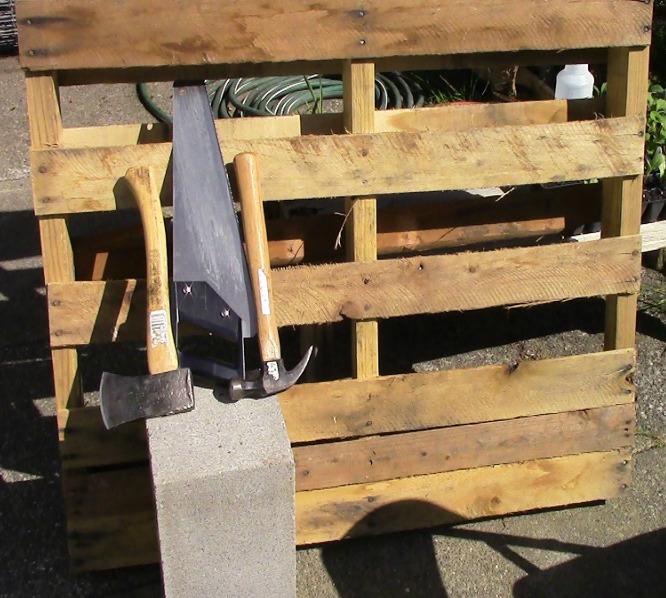 Pallet: look for a pallet that has at least 4 intact boards (the more the better in case of splitting while prying) that are held on by no more than about 6 nails each. This will make it easier to pry the boards loose.
Pallet: look for a pallet that has at least 4 intact boards (the more the better in case of splitting while prying) that are held on by no more than about 6 nails each. This will make it easier to pry the boards loose.
Also, make sure your pallet is free from any kind of liquid or other contaminant that you do not want in your garden.
Hammer: You will use both the hammer end and the prying end, so a regular hammer is needed.
Hatchet: This does not need to be sharp as it will only be used to wedge.
Saw: I use a hand saw, but any kind of saw that cuts wood will work.
Cinder Block: This just needs to have a flat surface and a square corner so you can straighten the nails you pull out of the pallet for re-use.
CONSTRUCTION
Set your pallet up against a wall or something that will support your prying at the boards with your hatchet and hammer.
 Being careful not to split the wood too much, hit your hatchet in between the end of a board and the cross beam it is nailed into. Pry back and/or forth. Move the hatchet around, trying different angles until you are able to pry. I press with my foot at the base of the pallet to help keep it from moving around while I wedge and pry.
Being careful not to split the wood too much, hit your hatchet in between the end of a board and the cross beam it is nailed into. Pry back and/or forth. Move the hatchet around, trying different angles until you are able to pry. I press with my foot at the base of the pallet to help keep it from moving around while I wedge and pry.
Each pallet is different. Some have thicker boards than others, but this one I am using in this example has very thin boards, so I am wedging with the hatchet at each corner. It helps to hit the side of the hatchet near its butt end with the hammer if it isn’t moving back and forth easily.
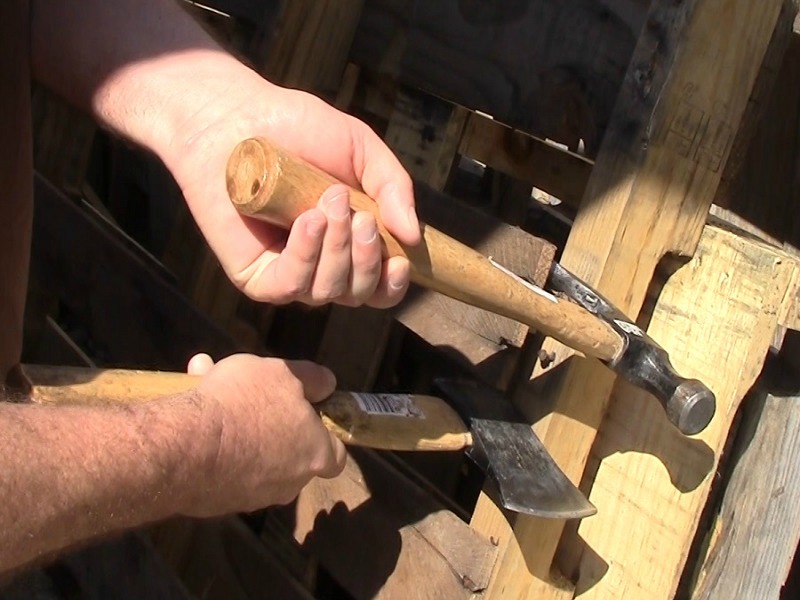 I then wedge the hatchet in the center, in between the nails, after wedging at each corner.
I then wedge the hatchet in the center, in between the nails, after wedging at each corner.
As with prying with the hatchet, I pry gently with the hammer alternating a few times between the nails if need be to avoid splitting the boards.
Gently use the pry end of the hammer to free the center of the board. Repeat until you have removed all of the center boards.
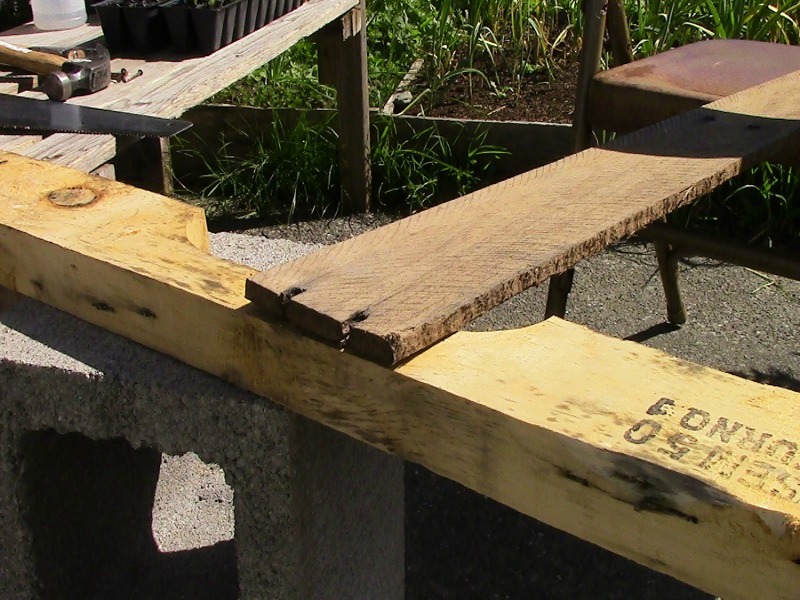 Place the end of 1 board in the narrow section of crossbeam to where you can get 2 blocks of the same width as the board out of the narrow section. If your board width is larger than would be accommodated by the narrow part of the crossbeam, that is ok, as any part of the cross beam can be used. I just like to use the narrow part as that is less to cut through and is all that is needed.
Place the end of 1 board in the narrow section of crossbeam to where you can get 2 blocks of the same width as the board out of the narrow section. If your board width is larger than would be accommodated by the narrow part of the crossbeam, that is ok, as any part of the cross beam can be used. I just like to use the narrow part as that is less to cut through and is all that is needed.
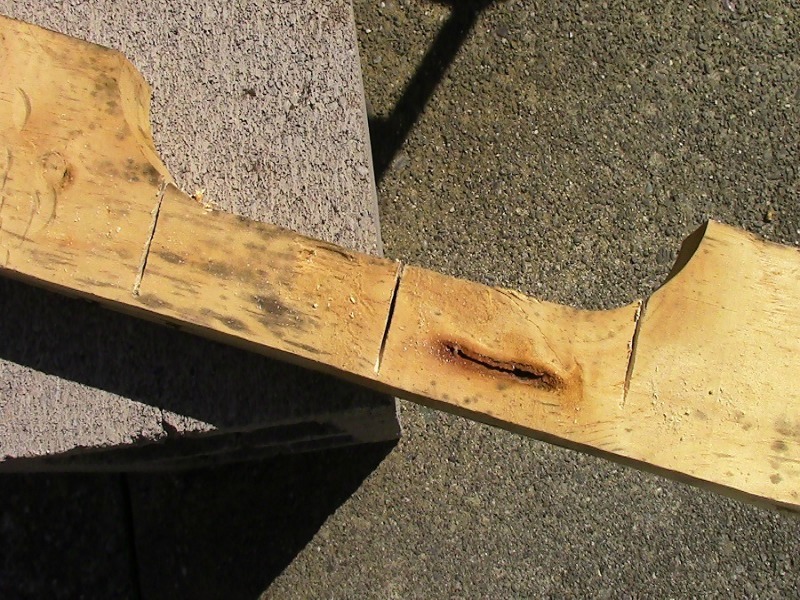 You will make 3 cuts that are spaced from each other the width of the boards. This results in the 4 crossbeam blocks you will need in order to nail the 4 boards together into a square.
You will make 3 cuts that are spaced from each other the width of the boards. This results in the 4 crossbeam blocks you will need in order to nail the 4 boards together into a square.

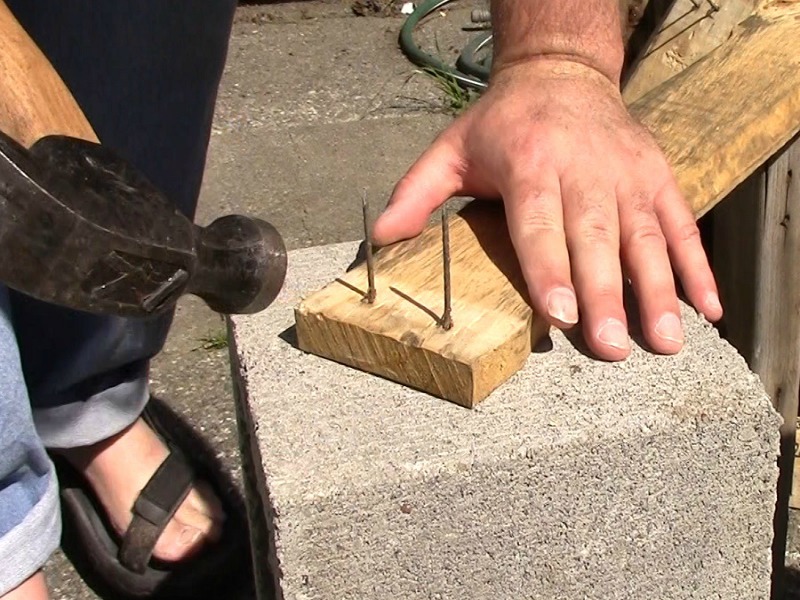 If the nails at the ends of the boards are usable as is… sometimes they just need a little straightening… then hammer them into 1 of the 4 crossbeam blocks.
If the nails at the ends of the boards are usable as is… sometimes they just need a little straightening… then hammer them into 1 of the 4 crossbeam blocks.
 If they are not usable because their tips are dull or they are too bent… hammer them out and use different ones or straighten them, and then use them to hammer the board into the cross beam blocks.
If they are not usable because their tips are dull or they are too bent… hammer them out and use different ones or straighten them, and then use them to hammer the board into the cross beam blocks.
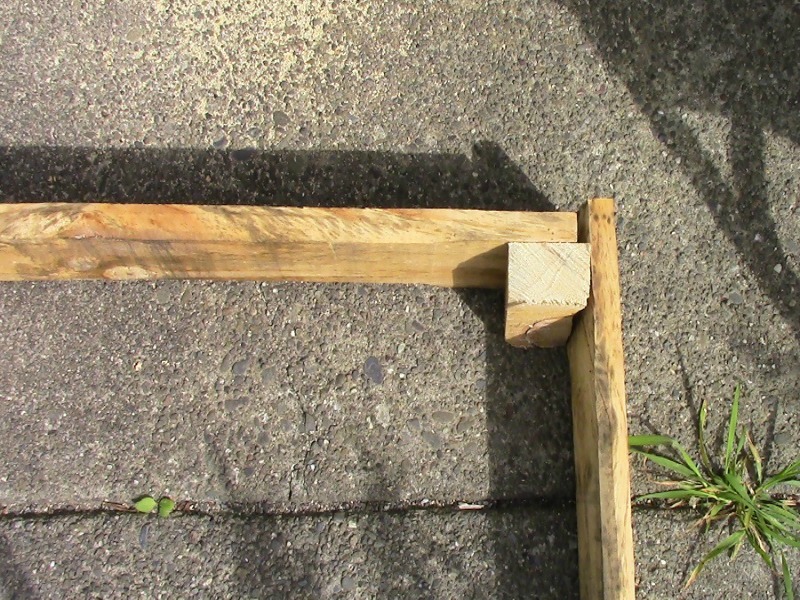 You will now have 2 boards with 1 crossbeam block at each ends, and 2 boards without crossbeam blocks.
You will now have 2 boards with 1 crossbeam block at each ends, and 2 boards without crossbeam blocks.
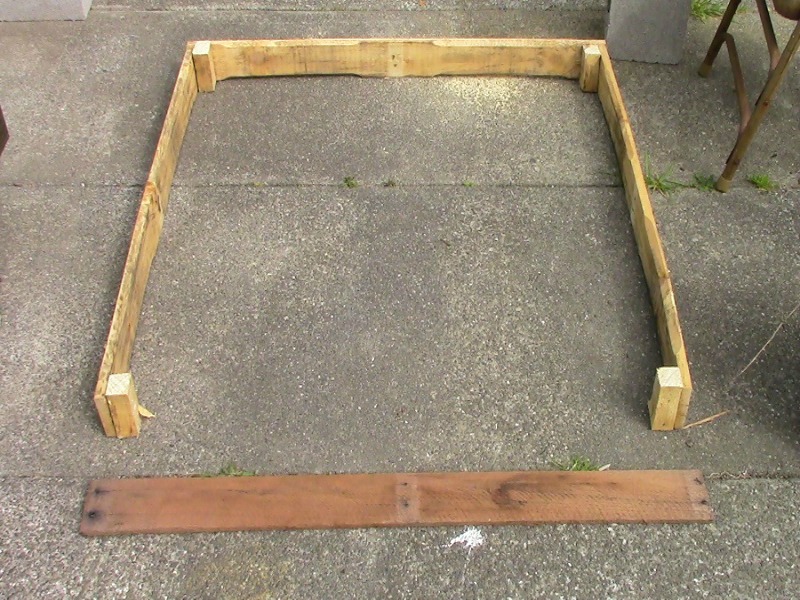 Hammer the boards without crossbeam blocks at the ends into the boards with the crossbeam blocks to form a square.
Hammer the boards without crossbeam blocks at the ends into the boards with the crossbeam blocks to form a square.
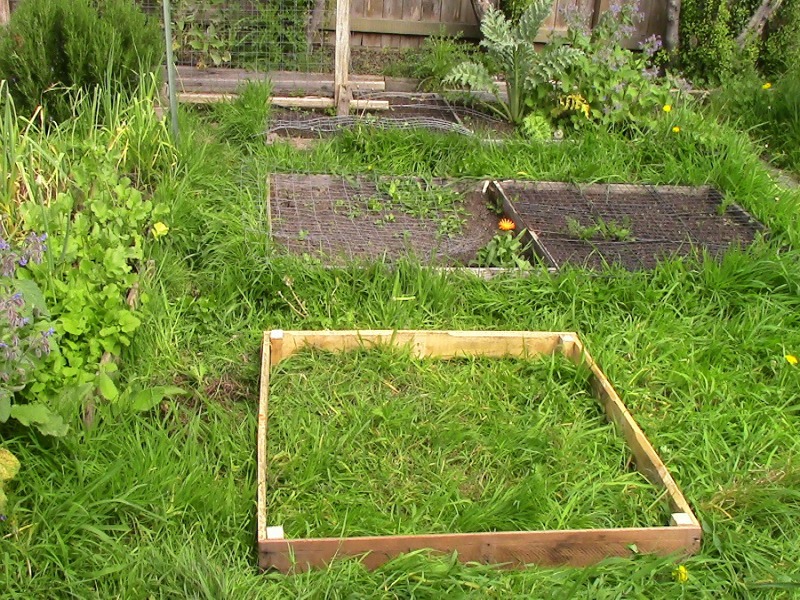 Place your new raised bed where you want it in your garden.
Place your new raised bed where you want it in your garden.
 Optionally put in some organic material.
Optionally put in some organic material.
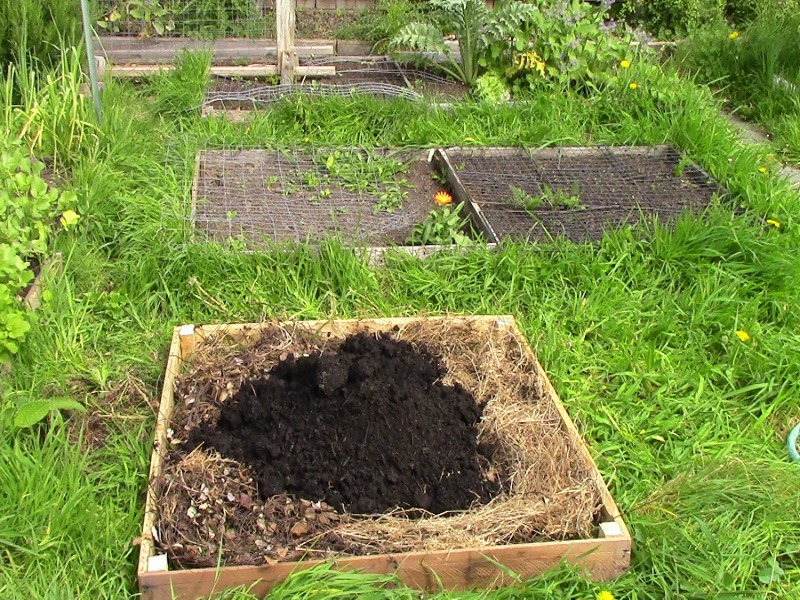 Add soil and plant!
Add soil and plant!
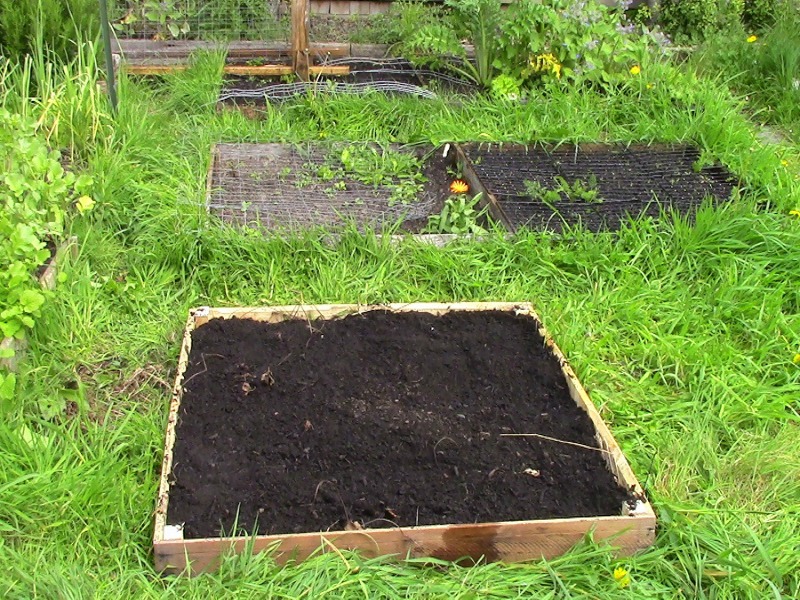
About Troy Boylan
 Ecoculture Village Founder & President; Anthropology BA, Interdisciplinary Studies: Ethnobotany BS. Two things I think are worth anything at all… all things wilderness and ecoculture.
Ecoculture Village Founder & President; Anthropology BA, Interdisciplinary Studies: Ethnobotany BS. Two things I think are worth anything at all… all things wilderness and ecoculture.
Mike, You heard about the benefits of using Biochar to build up poor soils?
Charles,
I have but I don’t know much about it.
Great idea! I love reusing things. The only thing I would add is to first place cardboard down over lapping so grass & weeds don’t come up through your organic material & soil. Saves a lot of time weeding. You can usually find big pieces behind furniture & appliance stores.
As a formal pest control guy
Using cardboard or any kind of cellulose produce will attract termites
I have seen this multiple times here in central Florida
If you have a piece of 2X4 around you can do this. Lift up the pallet about 4″ above the ground using another pallet. With the first board over space pass the 2X4 through other boards and against the surface of the board and hit the 2X4, it will drive out the entire board, including nails, usually without splitting, move it over to the center then the other end. Once you drive off one side flip it over and drive off the other boards. I used to make simple furniture from pallets and this method worked for me.
Scott, that sounds easy. I will try it.
Nice idea to use pallets. I have a few pieces of LONG pressure treated, 6″ x 1-1/4″ deckwood. Obviously, I am reluctant to use them for a raised garden box due to the green chemical treated into the wood. However, these wood pieces are now 20-25 years old. Any harm using them for vegetables?
Howard,
I wouldn’t hesitate to use them for a flower bed, but for edible things???? I’d consult with the company that treats or sells the wood. They probably have info on their website.
“green?” if the chemical was really green, that is copper. I have used it to protect such things as doors and casings. But, I looked it up and found this: http://www.finegardening.com/are-pressure-treated-woods-safe-garden-beds….don’t know what to say now
Just line staple a piece of plastic to the inside of the raised bed to isolate the green treated wood and go under the wood and to the outside of the raised bed.. The idea is to keep the green wood isolated from the growing medium. The reason to go under the green treated wood and outside away is that any water that is contaminated by and chemicals will be drained or flow away from the growing medium. Water pressure is an incredible force.
Save time by using Sawzall to cut the nails holding th pallet together. Many times the cement-coated nails used in pallets are real bears to pull out, often cracking th boards before being pulled free.
Always ask before taking a pallet. Oftentimes pallets are stacked for reuse. Home Depot uses the pallets over and over again, until they are no longer usable. Cheff (blue) pallets and Sacrete (yellow) pallets are deposit pallets, requiring return to the vendor and therefore should not be taken without permission.
Thanks Jerry, all excellent points.
Jerry, great tip, sometimes I find that whacking through the nail with the hatchet is easier than prying.
I make a great tool for popping those boards right off those pallets!!! Any one that breaks down pallets needs one of them. Can have all the boards off of one in seconds!!
What tool would that be?
disassembly is faster using a reciprocating saw with a long metal cutting blade.
I’ve heard that if the pallet has ” HT ” on it, it’s heat treated so no pesticides.
I’ve read the letter but it won’t let me watch the video. I have to wait till my husband gets home for the $7 charge. I live in south Texas. Will you have info for my area in the book?
Marcelyn,
Check your Email for a link to the video. All information about plants is pretty much universal, we have people successfully grown plants in every state in the U.S. and in other parts of the world. Plant selection varies from zone to zone, but the techniques of growing them do not change much at all.
if there is the possibility that the pallets have been chemically treated…..buy 8 foot long 1/2″ or 3/4″ thick insulation foam sheets and cut to size of finished bed sides and use foam adhesive to attach to inside of bed walls thus soil will not be in contact with wood
I have heard thT some.pallets are sprayed with chemicals to deter bug/vermin from whatever gets shippend on.said pallets. How does.one know.if any pallets are toxin free? Why are some.pallets cores, is.it.a code?
Ingrid, I believe used pallets are called cores. It’s the industry term for a used 48 X 40 wooden pallet.
You can usually tell upon examination. Look for stains, smells and any physical signs. Stay away from sources that use pallets for food and chemical delivery. If a pallet has blue markings is or was a Wal-Mart pallet. Stay away from blue pallets. No one really knows where they’ve been. A local lumber or hardware store is a great source. Sometimes FREE!! I’ve built chicken coops, potting benches, hothouse work tables, garden beds, bat houses, bird houses and a fish cleaning station complete with a sink and mounted inside icebox; all from FREE pallets from my local hardware store. Pallets are sometimes a bit difficult to work with because the wood is VERY hard. BE PATIENT….It’s worth it.
Good luck,
JR
pallets are wonderful, but try and source American-made pallets: ever since the disastrous importation of the Formosan termites on pallets ca. WW II, most imported pallets are treated with either heavy metal salts or chlorinated hydrocarbons to kill pests. You don’t want these anywhere near your veggie patch. Or if you’re a curmudgeon like me, anywhere on your place (especially for fuel) :=)
I was very surprised to see you wearing open Sandals and bare Feet surrounded by Timber and Rusty Nails…not a good example for any potential viewer…Some People might think that’s the Norm’..I enjoy your Tips and Ideas but “Please” think carefully about your Footwear for Novice Viewers who may not be so mature…
Regards…Dave…
Thanks Dave, but that’s not me in the photos. The images were submitted by somebody else.
Thanks for pointing that out, Dave. Safety first always.
Will not let me pin to pintrest
Whoa! Better put some cardboard, thick newspaper, old carpet or thick cloth down on that grass BEFORE putting the soil in your box or you’ll be growing a great crop of grass!
I agree, Diane. I usually put down cardboard, but not always, and usually not when I put down organic material which can serve the same purpose as well depending on its thickness. When I do use cardboard, I usually overlap it so it forms a slightly larger footprint than the raised bed, as the most aggressive grass will often occur where the soil in the bed meets the bed wall boards.
I use pallets around the garden and for kindling wood. Was cautioned by people that they contain pesticides and other anti rot compounds. Did some research. If the pallets are for food purposes….. as in grocery stores, they are NOT treated with anything . Could be some paint here and there but no bad contaminants
I am wanting to do this soon, good to know Bill, thanks
Thanks Bill, I have found this to be true as well. It is a good idea to check your pallets for any strange stains… could just be grocery related, but it could also be other products. I have not had any problems personally with contamination on any pallets.